Introduction
Processing 1099 forms is a critical task for businesses, but it’s often marred by inefficiencies that can lead to significant delays. This blog explores practical strategies to mitigate common issues that slow down 1099 processing. By understanding these challenges and implementing effective solutions, businesses can streamline their 1099 processes, ensuring timely and accurate compliance with tax regulations.
Understanding 1099 Processing Challenges
1099 processing involves reporting income paid to non-employees. Common issues include data inaccuracies, manual processing, lack of standardized procedures, and last-minute rushes. These challenges can result from outdated systems, insufficient planning, and inadequate understanding of tax laws. Delays in 1099 processing not only cause compliance risks but also can lead to penalties and strained relationships with contractors.
Strategies to Mitigate Common 1099 Processing Issues
- Early Preparation and Planning: Start the 1099 process well before the deadline. Early preparation includes gathering and verifying taxpayer identification numbers (TINs) and other relevant information from contractors.
- Standardizing Procedures: Develop a standardized process for collecting and verifying information. This includes creating templates for information collection and setting internal deadlines that precede the IRS deadline.
- Utilizing Automation Tools: Implement software solutions designed for 1099 processing. These tools can automate data entry, validation, and submission, significantly reducing manual errors and processing time.
- Regular Data Updates and Verification: Maintain up-to-date records throughout the year. Regularly update and verify the accuracy of contractor information, including names, addresses, and TINs. This proactive approach prevents the common issue of last-minute data corrections.
- Training and Educating Staff: Ensure that staff responsible for 1099 processing are well-trained and understand the latest tax laws and reporting requirements. Regular training sessions can keep the team updated on new regulations and best practices.
- Integrating Systems: If possible, integrate 1099 processing software with your accounting or payroll systems. This integration can streamline data transfer, reducing the need for manual data entry and the risk of errors.
- Conducting Internal Reviews: Implement a process for internal reviews of 1099 forms before submission. This step can catch errors or discrepancies that might have been overlooked.
- Communication with Contractors: Establish clear communication channels with contractors. Inform them about the information required and the deadlines for submission. Prompt communication can prevent delays caused by incomplete or inaccurate information from contractors.
- Seeking Professional Assistance: For businesses with a large number of contractors or complex 1099 requirements, consider seeking assistance from tax professionals. They can provide expert advice and help streamline the process.
- Leveraging Electronic Filing: Utilize the IRS’s electronic filing system, which is faster and more reliable than paper filing. Electronic filing also provides immediate confirmation of submission.
Addressing Specific 1099 Variants
Different types of 1099 forms (e.g., 1099-MISC, 1099-NEC) have specific requirements. Understanding the nuances of each form is crucial. Tailor your processes to address the unique aspects of each 1099 variant to ensure accurate and timely filing.
Conclusion
Efficient 1099 processing is achievable through early planning, automation, standardization, and education. By addressing common issues proactively, businesses can ensure a smoother, faster 1099 processing experience, avoiding penalties and maintaining good relationships with contractors. Implement these strategies to transform your 1099 processes into an efficient, compliant system.

